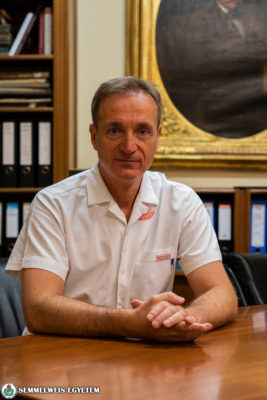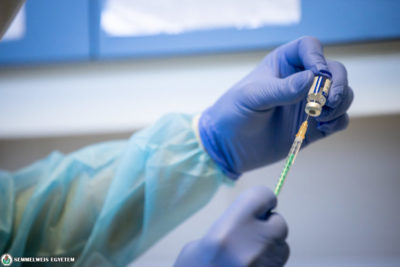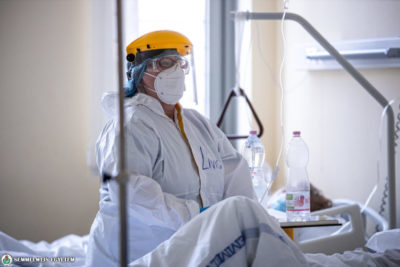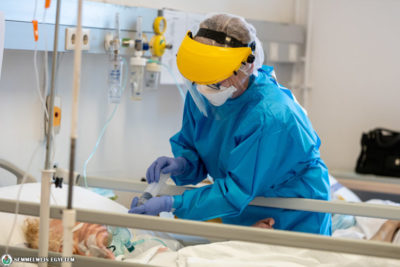Semmelweis University has participated in the care of coronavirus patients since the onset of the epidemic. Almost 6,000 COVID-19 patients have been treated at the departments of the university since the beginning of the first wave. As part of our series introducing organizational units involved in COVID patient care, the directors of the Department of Otorhinolaryngology, Head and Neck Surgery, and the Department of Obstetrics and Gynecology as well as the Institute of Genomic Medicine and Rare Disorders will talk about their experiences.
“The epidemiological situation contributed to the broadening of horizons of our specialists and residents, they had the opportunity to be enriched with plenty of useful experiences”
Dr. László Tamás, Director, Department of Otorhinolaryngology, Head and Neck Surgery
 The Department of Otorhinolaryngology, Head and Neck Surgery played an important role in COVID patient care at the university, with different responsibilities carried out at the different epidemic waves.
The Department of Otorhinolaryngology, Head and Neck Surgery played an important role in COVID patient care at the university, with different responsibilities carried out at the different epidemic waves.
“We have moved our clinical units to one half of the Department of Orthopedics so that their hospital beds may provide the background for the emergency department. In terms of COVID-19, we basically operated as a diagnostic and training center for PCR testing. In the first months, we were responsible for the testing of the staff members and the patients in the departments of the Outer Clinical Block. Meanwhile, we also trained the staff members appointed by the departments on the techniques of proper screening”, said Dr. László Tamás, Professor, Director of the Department of Otorhinolaryngology, Head and Neck Surgery.
He also pointed out the introduction of a new compulsory course for the 4th year, 5th year and 6th year students of the Faculty of Medicine entitled “The comprehensive theory of coronavirus and the practice of how to test samples taken from the respiratory tract”. Specialists from the Institute of Medical Microbiology, the Department of Laboratory Medicine, the Department of Radiology, the Department of Internal Medicine and Hematology, the Department of Hospital Hygiene and the Department of Otorhinolaryngology, Head and Neck Surgery all participated in the teaching of this subject.
“During the second wave, my colleagues provided support in the fight against the coronavirus at the university’s larger COVID care facilities. In the meantime, our department handed over the second floor to the Department of Neurology, where those neurological patients were treated who were not infected by COVID-19”, highlighted Dr. László Tamás.
In the third wave, because of the increasing case numbers, the entire building of the Department of Otorhinolaryngology, Head and Neck Surgery became a COVID patient care provider. Three COVID units, gray and red zones, as well as hospital monitoring rooms equipped with cameras and rooms suitable for getting medicine ready have been established. Starting from 5 March, 2021, exclusively COVID-19 patients were treated at the department with a capacity of 56 hospital beds. Their own, non-infected patients were being taken care of in the green zone at the 1st Department of Surgery and Interventional Gastroenterology with a capacity of 16 hospital beds.
“Piped oxygen supply was installed only in a few places at the department. Because of the outbreak of the epidemic, the planned further installation was delayed. In the absence of a piped medical gas system, we could only solve the oxygen supply of our coronavirus patients with portable oxygen cylinders. This is one of the reasons why the Department of Otorhinolaryngology, Head and Neck Surgery became a COVID care provider only in the course of the third epidemic wave”, the Director explained.
In addition, it was also difficult to reorganize the work of the nurses and physicians: they started working in shifts instead of on-call systems. Working in shifts have been typical so far only in the case of nurses, but during the third wave, both the staff members of the operating room and the physicians worked in this system.
Dr. László Tamás also emphasized the professional support that their department received from both the Department of Internal Medicine and Hematology as well as from the Heart and Vascular Center.
“It has not been an easy task for us, otorhinolaryngologists, to treat coronavirus patients suffering from illnesses related to general internal medicine or severe cardiac diseases. At our department, we primarily treat patients with head and neck tumors, severe ear disorders, suffocation and related problems, diseases of the nasal cavity and paranasal sinuses, and thyroid disorders, therefore the help provided by internists, cardiologists and residents was a huge support. The work carried out by nursing staff transferred from other departments and the work of volunteer helpers, medical students, and soldiers was also an important support for us. In addition to being a COVID care provider, our screening center also continued to operate. With the increase of the number of COVID-19 cases, we received help from the 2nd Department of Pathology to perform PCR testing, therefore our colleagues working there could return to the work at COVID patient care”, recalled Dr. László Tamás.
As the number of infections decreased, COVID patient care was discontinued at the Department of Otorhinolaryngology, Head and Neck Surgery in May. Regarding the experiences of the pandemic period, the director highlighted the attitude of staff members, as well as the amount of experience they gained in treating coronavirus patients.
“The epidemiological situation contributed to the broadening of horizons of our specialists and residents. The fact that they had the opportunity to treat COVID-19 patients by working together with internists and cardiologists helped them to be enriched with plenty of useful experiences”, emphasized Dr. László Tamás.
“Obstetric care cannot be discontinued even in an epidemiological situation”
Dr. Nándor Ács, Director, Department of Obstetrics and Gynecology
 “Our department already treated expectant mothers who were infected with COVID-19 last spring, therefore we have been involved in COVID patient care since the outbreak of the epidemic in Hungary”, said Dr. Nándor Ács.
“Our department already treated expectant mothers who were infected with COVID-19 last spring, therefore we have been involved in COVID patient care since the outbreak of the epidemic in Hungary”, said Dr. Nándor Ács.
According to the director of the Department of Obstetrics and Gynecology, there were infected patients on a weekly basis during the first wave, but they did not have severe symptoms typical of COVID-19 requiring special care. However, the department had to deal with the care of those expectant mothers or gynecology patients whose PCR test turned out to be COVID-19 positive.
“We separated wards and two operating rooms for them, as well as created a dressing area for colleagues entering the red zone. We also organized trainings and made a tutorial video”, recalled Dr. Nándor Ács.
According to the director, due to the increasing number of COVID cases in the third wave of spring 2021, they had to reorganize work at the department to an even greater extent. The department’s building located on Baross street functioned as a COVID-free green zone, while an entire floor in the building located on Üllői street was converted into a red-zone COVID unit.
“While the number of expectant mothers with severe coronavirus symptoms was relatively low in the first two waves, yet the third wave brought a change in this respect as well. There was a significant increase in the number of expectant mothers who became seriously ill because of the infection: at the peak of the epidemic, 27 pregnant women in need of oxygen supply were treated at the department at the same time”, said the Director.
In addition to expectant mothers, a small number of newborns infected with coronavirus were also treated at the Department of Obstetrics and Gynecology, but none of them had serious problems. According to Dr. Nándor Ács, the largest challenge for their department was the reorganization of patient care.
“We are the largest obstetric institution in Hungary with a very high number of births. In addition, obstetric care cannot be discontinued even in an epidemiological situation”, the Director pointed out.
He added that at the domestic level, most expectant mothers infected with COVID-19 were cared for at the Department of Obstetrics and Gynecology of Semmelweis University, who were admitted by the department not only from the university’s intensive care units, but from various parts of the country as well. According to Dr. Nándor Ács, professors and associate professors have also returned to take care of the increased workload, but there has also been a heavy burden on nurses, midwives and the entire staff.
“A midwife of the red zone dressed up in protective clothing may not know when she can leave the zone, because it is usually unknown whether an expectant mother will give birth to her child in one hour or in six hours. In addition, at our department some surgeries not only involve obstetricians and midwives, but also anesthesiologists, pediatricians and additional staff members. That is why I am extremely grateful to my colleagues for working so hard and being so dedicated even in this challenging epidemic situation”, pointed out Dr. Nándor Ács, who also highlighted the importance of vaccination.
“Everyone reacted to the unforeseen situations in a different way, but we were able to strengthen each other and to cooperate in a team”
Dr. Mária Judit Molnár, Institute Head, Institute of Genomic Medicine and Rare Disorders
 “Staff members of the Institute of Genomic Medicine and Rare Disorders have been involved in the fight against the coronavirus for the past year, initially working at various university departments and external care facilities such as the Korányi National Institute of Pulmonology, as well as assisting with screening and vaccination. And in the third wave of 2021, our institute also became an active COVID care provider unit”, highlighted Dr. Mária Judit Molnár, Professor, Head of the Institute of Genomic Medicine and Rare Disorders.
“Staff members of the Institute of Genomic Medicine and Rare Disorders have been involved in the fight against the coronavirus for the past year, initially working at various university departments and external care facilities such as the Korányi National Institute of Pulmonology, as well as assisting with screening and vaccination. And in the third wave of 2021, our institute also became an active COVID care provider unit”, highlighted Dr. Mária Judit Molnár, Professor, Head of the Institute of Genomic Medicine and Rare Disorders.
She also added that their institute treated approximately 60 patients infected with coronavirus with a capacity of 12 hospital beds in the course of two months.
“We are a small organizational unit with few nurses, therefore a reorganization was needed within the institute, but in the end we managed to overcome the difficulties”, said Dr. Mária Judit Molnár.
“Our laboratory assistants worked as auxiliary nurses, but we also received external help: not only nurses or staff of the operating room from other departments supported us, but in case of professional questions we could always turn to the specialists of the Department of Pulmonology or the departments of internal medicine at any time, who continuously held consultations for us. The situation resulted in the fact that an extremely close relationship was built between our institute and the Emergency Department, the Department of Anesthesiology and Intensive Therapy as well as the University Pharmacy and the Department of Pharmacy Administration. Thanks to the Clinical Center, the patient care hierarchy functioned very well, and everybody knew what to do and what his/her responsibilities were. In such an extreme situation it is especially important, since it provides safety”, pointed out the Head of the institute.
According to Dr. Judit Mária Molnár, all the staff members of the institute were able to adapt to the new tasks: those who mainly deal with diagnostics and analyze DNA or blood are now performing nursing tasks. She also added that in certain cases, if it was needed, professors and physicians also carried out such tasks. Furthermore, as she pointed out, this provided an opportunity to learn even more about the importance of empathy.
“Many people think that for us, as experts in rare disorders, treating coronavirus patients who require a care predominantly focusing on internal medicine and pulmonology, is less suitable. However, I think that in order to treat rare disorders well, a holistic approach is needed: the entire person must be looked at by considering all his/her diseases. This is also true for COVID patient care”, she explained.
Dr. Mária Judit Molnár highlighted the importance of resilience primarily from the experience of recent years.
“Everyone reacted to the unforeseen situations in a different way, but we were able to strengthen each other and to cooperate in a team. When we were given a task, our aim was to try to solve it because it could save lives. A kind of collective resilience was being developed”, she recalled.
In addition to being involved in COVID patient care, their institute had to provide care for their own patients as well.
“We took a large step towards telemedicine: we taught our patients how to use Skype or Zoom, or how to virtually forward the right documents to us so we could stay in touch online. In the case of those in need of inpatient care, we cooperated with hospitals outside of Budapest”, Dr. Mária Judit Molnár said.
The institute is constantly trying to help with vaccination: they have informed their own patients suffering from rare diseases about which vaccines are recommended for them, and the institute has also regularly shared profession-specific news with their patients.
Ádám Szabó
Photo: Attila Kovács – Semmelweis University
Translation: Katalin Illés-Romhányi


